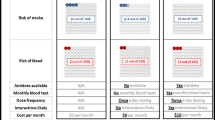Abstract
In two consumer studies, discrete choice surveys were administered both by telephone and by traditional pencil and paper methods. Study participants responded to discrete choice surveys concerning pizza restaurants in the first study and fast food restaurants in the second. Neither aggregate level estimated utilities for the pizza restaurants, nor market shares for the fast food restaurants differed by method of administration. The results indicate that discrete choice surveys can be successfully administered by telephone.
Similar content being viewed by others
References
Batsell, Richard R. and Leonard M. Lodish. 1981. “A Model and Measurement Methodology for Predicting Individual Consumer Choice.”Journal of Marketing Research 18 (February): 1–12.
Bishop, George F., Hans-Jurgen Hippler, Norbert Schwarz, and Fritz Strack. 1988. “A Comparison of Response Effects in Self Administered and Telephone Surveys.” InTelephone Survey Methodology. Eds. Robert M. Groves, Paul P. Biemer, Lars E. Lyberg, James T. Massey, William L. Nicholls II, and Joseph Waksberg. New York: John Wiley and Sons, 321–340.
Cochran, William G. and Gertrude M. Cox. 1957.Experimental Designs. Second Edition. New York: John Wiley and Sons.
Cooper, Lee G. and Masad Nakanishi. 1990.Market Share Analysis: Evaluating Competitive Marketing Effectiveness. Second Edition. Boston: Kluwer Academic Publishers.
de Leeuw, Edith D. and Johannes ven der Zouwen. 1988. “Data Quality in Telephone and Face to Face Surveys: A Comparative Meta-Analysis,” InTelephone Survey Methodology. Eds. Robert M. Groves, Paul P. Biemer, Lars E. Lyberg, James T. Massey, William L. Nicholls II, and J. Waksberg. New York: John Wiley and Sons, 283–299.
Elrod, Terry. 1991. “Conjoint Analysis by Telephone.” Unpublished paper. University of Alberta.
Fowler, Floyd J. 1988.Survey Research Methods. Beverly Hills: Sage.
Frey, James H. 1989.Survey Research by Telephone. Second Edition. Beverly Hills: Sage.
Green, Paul E. and Vithala R. Rao. 1971. “Conjoint Measurement for Quantifying Judgmental Data.”Journal of Marketing Research 8 (August): 355–363.
Green, Paul E. and V. Srinivasan. 1978. “Conjoint Analysis in Consumer Research: Issues and Outlook.”Journal of Consumer Research 5 (September): 103–123.
Green, Paul E. and V. Srinivasan. 1990. “Conjoint Analysis in Marketing Research: New Developments and Directions.”Journal of Marketing 54 (October): 3–19.
Johnston, John. 1984.Econometric Methods. Third Edition. New York: McGraw-Hill Book Company.
Louviere, Jordan J. 1988a.Analyzing Decision Making: Metric Conjoint Analysis. Beverly Hills: Sage.
————— 1988b. “Conjoint Analysis Modelling of Stated Preferences.”Journal of Transportation Economics and Policy 22 (January): 93–119.
Louviere, Jordan J. and Gary J. Gaeth. 1988. “A Comparison of Rating and Choice Responses in Conjoint Tasks.”Sawtooth Software Conference on Perceptual Mapping, Conjoint Analysis and Computer Interviewing. Ketchum, ID: Sawtooth Software.
Louviere, Jordan J. and George Woodworth. 1983. “Design and Analysis of Simulated Consumer Choice or Allocation Experiments: An Approach Based on Aggregate Data.”Journal of Marketing Research 20 (November): 350–367.
Mahajan, Vijay, Paul E. Green, and Stephen M. Goldberg. 1982. “A Conjoint Model for Measuring Self- and Cross-Price/Demand Relationships.”Journal of Marketing Research 19 (August): 334–342.
Stahl, Brent. 1988. “Conjoint Analysis by Telephone.”Sawtooth Software Conference on Perceptual Mapping, Conjoint Analysis, and Computer Interviewing. Ketchum, ID: Sawtooth Software.
Swait, Joffre and Jordan J. Louviere. 1991. “The Role of the Scale Parameter in the Estimation and Use of Generalized Extreme Value Models.” Unpublished paper. University of Alberta.
Walker Research, Inc. 1990. “Industry Image Study.”Research on Research. Indianapolis: Walker Research, Inc.
Wilson, Terry C. 1984. “Collecting Conjoint Data Through Telephone Interviews.”Journal of the Academy of Marketing Science 12 (Fall): 190–199.
Wittink, Dick R. and Philippe Cattin. 1989. “Commercial Use of Conjoint Analysis: An Update.”Journal of Marketing 53 (July): 91–96.
Author information
Authors and Affiliations
Additional information
He received his Ph.D. in marketing from the University of Texas at Dallas. Dr. Perkins is interested in marketing research methodology and in the use of marketing research information in managerial decision making.
Dr. Perkins has published articles in theJournal of Marketing Research andPsychometrika. He is a member of the American Marketing Association, the Marketing Research Association, and the TIMS College of Marketing.
Jacqueline Roundy recently completed the M.S. degree in marketing from the Pennsylvania State University. In addition she holds an M.B.A. from the University of Utah. She is currently working in Europe.
Rights and permissions
About this article
Cite this article
Perkins, W.S., Roundy, J. Discrete choice surveys by telephone. JAMS 21, 33–38 (1993). https://doi.org/10.1177/0092070393211004
Issue Date:
DOI: https://doi.org/10.1177/0092070393211004



